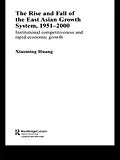Huang examines a recurring pattern of rapid economic growth in East Asia from 1951 to the present and explores how far a single East Asian Growth model can be said to exist. Assessing the various theories put forward to explain the phenomenon and supported by the most comprehensive data, the book finds that methods of institutional enhancement were at the core of the growth. This institutional enhancement affected state structure and functions, economic policy, corporate arrangements, social structure and relations, individual behaviour, and domestic and international interaction. Each of these elements was a critical aspect of the growth system that defined and propelled the rapid growth.
Autorentext
Xiaoming Huang is a senior lecturer in East Asian politics at Victoria University of Wellington, New Zealand. His research interests focus on the patterns of political and social change in different institutional settings, and frameworks for their meaningful description and explanation to people across critical boundaries, national, cultural or otherwise.
Inhalt
Part 1: Making Sense of the 50-Year Growth: Theories and Evidence Part 2: Initial Conditions: Growth Imperatives and Alternative Scenarios Part 3: Striving for Sustainable International Competitiveness Part 4: Cultural and Social Setting Part 5: Crafting The National Growth System Part 6: The Dynamism and Consequences of East Asian Growth Part 7: Conclusion: Institutional Competitiveness and East Asian Growth
